Set up and manage an AI/BI Genie space
This article explains how to set up and manage a Genie space, a chat interface for business users to ask natural-language questions about their data.
Technical requirements and limits
The following requirements and limits apply when using Genie spaces:
- Unity Catalog: The data for the Genie space must be registered to Unity Catalog. You can add up to 25 tables or views to a Genie space.
- Compute: Genie spaces require a pro or serverless SQL warehouse. You must have at least CAN USE permission on the selected warehouse. If this permission is missing, space creation fails.
- Throughput: Each workspace can handle up to 20 questions per minute across all Genie spaces when accessed though the Databricks UI.
- Capacity: Each Genie space can support up to 10,000 conversations, and each conversation can include up to 10,000 messages.
Required permissions
To create or edit a Genie space, you must have the following permissions and entitlements:
- Entitlements: You must have the Databricks SQL workspace entitlement. See Manage entitlements.
- Compute: CAN USE access on at least one pro or serverless SQL warehouse.
- Data access:
SELECTprivileges on the data used in the space. - Genie space ACLs: At least CAN EDIT permissions on the Genie space. Genie space creators automatically have CAN MANAGE permissions on spaces they create. See Genie space ACLs.
Configuring data and compute access requires elevated permissions, generally restricted to an administrator. See Create a SQL warehouse and Manage privileges in Unity Catalog.
Manage Genie access
Genie uses partner-powered AI features, which must be enabled at the account and workspace levels. To learn how to manage these features for your account, see Partner-powered AI features.
You must be an account administrator to manage access to this feature. If you disable Partner-powered AI features, users with the Databricks SQL entitlement can still click the Genie icon in the sidebar, but they cannot access any Genie spaces.
Create a Genie space
To create a Genie space:
- Click Genie in the sidebar.
- Click New in the upper-right corner of the screen.
- Choose the data sources that you want to include in your Genie space. Then, click Create.
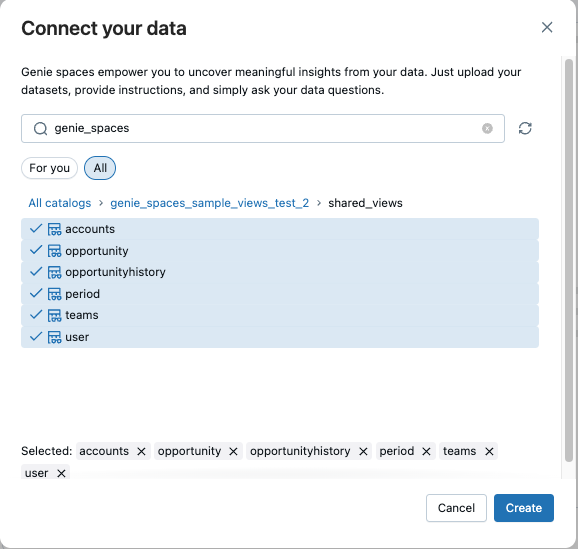
Review query suggestions
To learn about your space's data, Genie accesses information in your workspace to better understand relationships between tables and your business semantics. When you add data assets to a space, Genie automatically searches for relevant popular workspace queries associated with those assets. Your user credentials are used to find relevant queries for which you have at least CAN VIEW permissions. If the search returns queries, a notification appears in the Data tab of the Instructions panel. Click Review to see the suggested queries.
For more information about query access permissions, see Query ACLs.
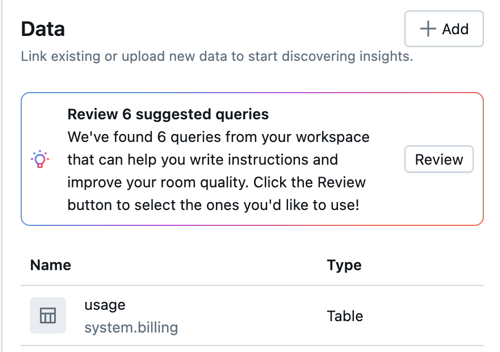
Use the Review Suggested Queries dialog to review, edit, accept, or reject the suggested queries. Other users with at least CAN EDIT access on the Genie space can review queries, provided they have at least CAN VIEW access on the query itself.

- The Title text is prepopulated with a question. Revise or edit the question by typing in the Title field.
- The Code field contains the complete text of the suggested SQL query. This field is not editable. To view the full query, click ... more lines.
- If you have sufficient permissions on the query, you can click SQL query to open the query in the Query history UI. See View query history.
- After you determine whether the query is relevant for your space, click Accept or Reject to add it to your space or dismiss the suggestion accordingly.
- Click the other suggestions to expand and review.
Accepted queries appear in the SQL Queries context for the space. After they are added to the space, the suggested queries and associated questions are fully editable. See Add example SQL queries and functions.
If no suggested queries are returned:
- You might not have sufficient access to relevant queries.
- There might be no relevant data. If queries have not run on your included tables, the search might not return results.
- Queries irrelevant to the Genie space are not considered. For example, queries that only perform basic write operations on the included assets are not considered relevant examples for Genie.
- Genie does not suggest queries on tables that are not added to the space. If you’ve created joined tables or views specifically for the Genie space, but relevant Databricks SQL queries typically run against a different source table, Genie does not return those queries in the results.
Manage data objects
To manage which data objects are included in a Genie space, click Configure > Data. Click the Add button to add more tables. Click the to the right of the table name to remove a table from the space.
Genie can query tables beyond those explicitly added to a space. Access is controlled by Unity Catalog permissions, not by the Genie space itself. While Genie uses the attached tables and views by default, users can query other tables by prompting for joins or editing SQL directly. Similarly, if instructions or metadata reference tables outside the space, Genie can include them in generated queries.
Build a knowledge store
A knowledge store is a collection of curated semantic definitions that improves Genie’s understanding of your data and increases response accuracy. Building a knowledge store lets you curate a space by customizing local metadata and defining concise, structured instructions. It contains changes that are scoped to a single Genie space. The space creator does not need write privileges on the underlying tables to edit and iterate on definitions, descriptions, or table relationships. These inputs help Genie interpret the data and return more accurate, relevant answers. See Build a knowledge store for more reliable Genie spaces.
Add SQL examples and instructions
You can add sample SQL queries, Unity Catalog functions, and plain-text instructions to help generate accurate responses. Click Configure > Instructions. Use the SQL Queries tab to manage queries and Unity Catalog functions. Use the Text tab to add plain text instructions.
You can add up to 100 instructions in total for a Genie space. Instruction types contribute to the count in the following ways:
- Each example SQL query counts as one.
- Each SQL function counts as one.
- The entire General instructions text block counts as one.
A Genie space aims to provide consistent and predictable responses based on clear and precise guidance. Because Genie operates in a nondeterministic manner, it’s important to make the guidance free from conflicting or ambiguous information to minimize the risk of undesirable responses. When setting up the space, a key task is to review and resolve any inconsistencies. This helps to achieve reliable results.
Add example SQL queries and functions
Use the SQL Queries tab to add the following:
-
Example queries (Recommended): Example SQL queries help Genie generate the correct SQL to answer common user questions. Queries can be static or parameterized. For each example SQL query, provide the SQL and use the most typical phrasing of the user’s question as the title. This improves Genie’s ability to match prompts to the example. Genie can either use the example query directly or learn from it to handle similar questions. When a parameterized query is used, the response is marked as Trusted. Users with CAN EDIT privileges in the space can view the query used to generate the response, which helps with troubleshooting and refinement.
-
SQL functions: For questions that cannot be answered with a static or parameterized SQL query, you can register a custom function to Unity Catalog. Functions can be shared across your teams and used by Genie to answer specific questions. Responses that are answered using a SQL function are marked as Trusted. To learn more about using SQL functions in your Genie space, see Use trusted assets in AI/BI Genie spaces.
How Genie uses example queries
Example queries show Genie how to use the available data to answer questions. Enter a sample question into the text field, and then enter a SQL query that answers that question. Write the sample question the way a user would naturally ask it. When Genie receives a matching question, it can use the example query directly to provide an answer. When Genie gets a similar question, it uses clues from the example query to learn and structure the SQL provided in the response. Focus on providing samples that highlight logic that is unique to your organization and data, as in the following example:
-- Return our current total open pipeline by region.
-- Opportunities are only considered pipelines if they are tagged as such.
SELECT
a.region__c AS `Region`,
sum(o.amount) AS `Open Pipeline`
FROM
sales.crm.opportunity o
JOIN sales.crm.accounts a ON o.accountid = a.id
WHERE
o.forecastcategory = 'Pipeline' AND
o.stagename NOT ILIKE '%closed%'
GROUP BY ALL;
Add query parameters
Parameterized example queries allow space users to specify a specific value to be inserted in the query at runtime. To learn more about working with parameterized queries, see Use parameters in SQL queries.
Provide usage guidance
You can provide Genie additional context to explain when an example query is particularly relevant.
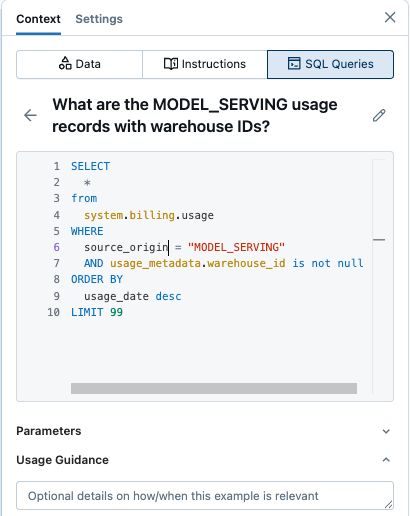
To add usage guidance:
- Click Configure > Instructions > SQL Queries to access the list of example queries.
- Click an example query.
- Click Usage guidance near the bottom of the screen.
- Enter details about how and when to use this example query.
How does Genie use SQL functions?
SQL functions are useful when a question involves complex logic that cannot be captured with a static or parameterized query. They are stored in Unity Catalog and can be called by Genie using user-supplied parameters. Genie cannot view or modify the SQL used in the function, making this approach well-suited for logic that should not be surfaced or changed. For guidance on registering a function in Unity Catalog, see Create a SQL table function and User-defined functions (UDFs) in Unity Catalog.
Provide instructions
Click the Text tab to write plain text instructions that help Genie understand how to respond to specific questions about your business. You can format the instructions as a single comprehensive note or categorize them by topic for better organization.
Instructions help guide Genie's responses so that it can process the unique jargon, logic, and concepts in a given domain. General text instructions apply to all prompts. If an instruction is relevant only to a subset of prompts, it should be included as an example query or function, or documented in the relevant table as comments or metadata. Text instructions are only for context that should be applied globally and do not fit into the other formats.
The following example includes information you could include in general instructions:
- **Company-specific business information**:
- Fiscal year starts in February, for example fiscal year 26 or FY26 is February 1, 2026 through January 31, 2027
- **Formatting**:
- Always respond in Spanish
- If no other specification exists, round all decimals to two places
- Omit commas in results for any column including "Id" or "id" or "\_id"
Configure settings
Customize your Genie space by configuring additional settings. Click Configure > Settings to access the following settings:
- Title: The title appears in the workspace browser with other workspace objects. Choose a title that will help end users discover your Genie space.
- Default warehouse: This compute resource powers the SQL statements generated in the Genie spaces. End users need access to this warehouse to interact with the space. A Genie space can use a pro or serverless SQL warehouse. For optimal performance, Databricks recommends using a serverless SQL warehouse.
- Description: Users see the description when they open the Genie space. Use this text area to describe the space's purpose. The description field supports Markdown formatting so that you can style your text and supply links to helpful context and references. For more information on markdown syntax, see the Markdown Guide cheat sheet.
- Genie file upload: If file uploads (Public Preview) are enabled for your Genie space, you can select Enable users uploading files to conversations. See Upload a file.
- Sample questions: Sample questions are optional. They appear in chats to provide examples of the types of questions users can ask. They can be added during creation or later from the space's Settings.
- Tags: Use tags to organize and categorize Genie spaces for easier management. See Add tags.
Expect to iterate on your Genie space based on testing and usage. For guidance on best practices for creating and iterating on a space, see Curate an effective Genie space.
Add tags
You must have at least CAN EDIT permissions on a Genie space to add a tag. To add a governed tag, you must also have the ASSIGN permission on the governed tag. Search is not supported using Genie space tags. For more information on tags, see Apply tags to Unity Catalog securable objects.
This feature is in Public Preview.
-
Click Configure > Settings.
-
Click General.
-
Under Tags, add or update a tag:
- If there are no tags, click the Add tags button.
- If there are tags, click the
Add/Edit tags icon.
-
Select an existing tag Key and Value or enter a name of a new tag.
- Tags that are governed are in the Governed section header and have a lock icon
.
- Tag keys are required. Whether a tag value is required depends on the tag key.
- Tags that are governed are in the Governed section header and have a lock icon
Test your Genie space
Most user interactions take place in the chat window. The best way to learn if your space is working as you want is to test it with realistic questions that you expect your business users to ask.
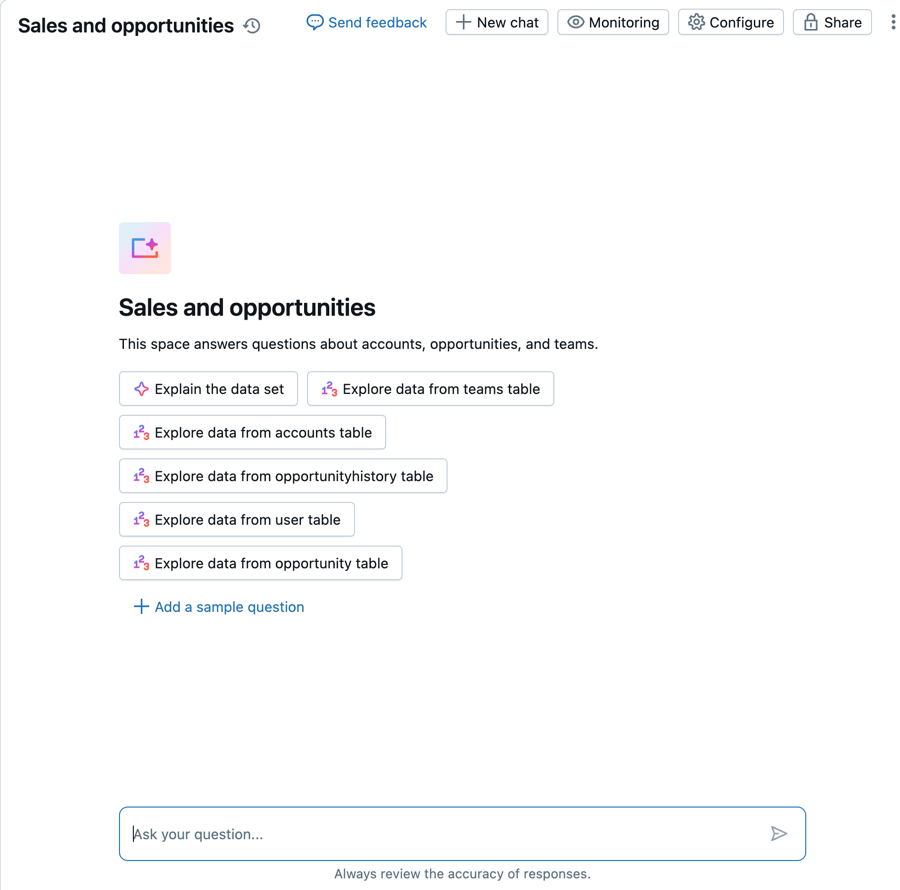
Sample questions configured in the space settings appear in the chat window. Genie can also generate sample questions based on the space's context to help users begin exploring the data. Users can click a sample question or enter their own questions in the text field at the bottom of the screen.
Responses appear above the text field. After a user enters a question, it is saved to the chat history.
To start a new conversation:
- Click New chat to start a new chat. Click
to open a previous conversation.
- Type your question into the Ask your question… text entry field.
Review responses
Responses are typically delivered as natural language answers to the questions and a table showing the relevant result set. When Genie detects that a visualization could improve response clarity, it also returns a visualization. The precise response structure varies based on the question. If a SQL query was generated to answer the question, it is included in the response.

Like other large language models (LLMs), Genie can exhibit non-deterministic behaviors. This means that you might occasionally receive different outputs when submitting the same prompt multiple times. Providing example SQL queries that Genie can learn from can help make Genie more consistent. See Add example SQL queries and functions.
Response feedback
Each response prompts the user to answer Is this correct?. Users can respond in one of the following ways:
- Yes: Confirms the response appears accurate.
- Fix it: Flags the response as incorrect. Users can select from common issues or enter their own explanation. They can then:
- Click Submit and try again to regenerate the response using the provided feedback.
- Click Submit to send the feedback without regenerating the response.
- Request review: Flags the response for manual review. Users can add an optional comment to give you additional context.
As an editor, you can view feedback and flagged responses in the Genie interface. Your Genie space's behavior does not change based on user feedback alone. You should use feedback to identify improvement opportunities or respond directly to user questions. Databricks recommends encouraging users to provide feedback on the space using this mechanism.
Business users can view updates to the questions they've marked for review on their Monitoring page. Users with at least CAN MANAGE permission on the Genie space can review the specific exchange, comment on the request, and confirm or correct the response. They can access feedback and review requests on the monitoring page. Then you can use that feedback to tune responses and iterate on your space. See Monitor the space.
Other response actions
For responses that include generated SQL, additional options allow you to interact with the returned data.
-
Copy CSV: Space users can download up to approximately 1GB of results data as a CSV. The final file download size might be slightly more or less than 1GB, as the 1GB limit is applied to an earlier step than the final file download. To download results, click the download icon in the response.
-
Show code: Click Show code to view the generated query. This can be useful for troubleshooting unreliable responses. See Edit and save queries.
-
The
kebab menu: Access the following actions:
- Copy CSV: Copy the response CSV to your clipboard.
- Add as instruction: For interactions that might be useful for teaching Genie how to answer similar questions, click Add as instruction. This opens the UI for saving example SQL queries, populated with the question and generated SQL. You can leave the example as written, or edit and save to make changes. See Add example SQL queries and functions.
- Add as benchmark: Add the question as a benchmark question. See Use benchmarks in a Genie space.
- Refresh data: Refresh the data by running the previously generated query.
- Regenerate response: Submit the question again and have Genie regenerate the response.
Edit and save queries
Genie's SQL queries can be reviewed for accuracy and edited as necessary. Genie space authors typically know the domain and data that allows them to recognize when Genie is generating an incorrect answer. Often, errors can be fixed with a small amount of manual tuning to the generated SQL query. Click Show generated code to inspect the query and view the generated SQL for any response.
You can edit the generated SQL statement to correct it if you have CAN EDIT or greater privileges on the Genie space. After you've made your corrections, run the query. Then, you can save it as an instruction to teach Genie how to answer in the future. To save your edited query, click Add as instruction.
Monitor the space
A Genie space can be thought of as a long-term collaboration tool between data teams and business users. It accumulates knowledge over time rather than serving as a one-time deployment. As users ask new questions, you can refine the space to improve coverage and accuracy.
Use the Monitoring tab to review individual questions and responses, view user feedback, and identify responses flagged for review.
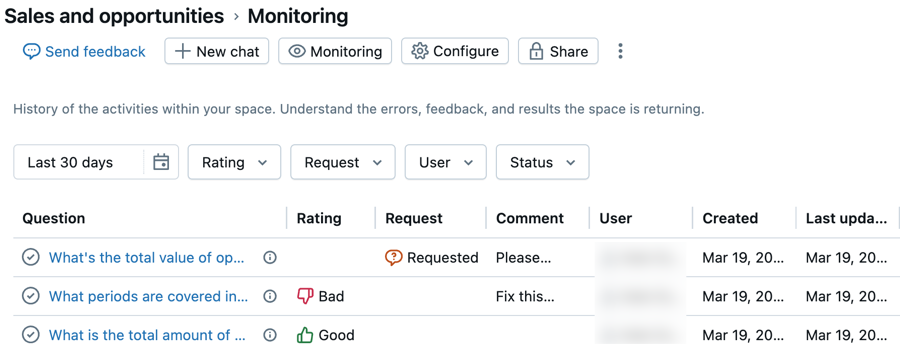
The monitoring tab shows all of the questions and answers that have been asked in the space. You can filter questions by time, rating, user, or status. By monitoring the space, users with CAN MANAGE permissions can proactively understand the queries raised by business users and how the Genie space responded.
Identifying the questions that Genie struggles with can help you update the Genie space with specific instructions to improve its responses. Click a question to open the question and response text and view the complete chat thread.
Share a Genie space
Genie space users must use their own credentials to access data. Any question about data they can't access generates an empty response.
When you share a Genie space, users must have the following permissions to interact with the space:
- Entitlements: The consumer access or Databricks SQL workspace entitlement. See Manage entitlements.
- Compute: At least CAN USE permission on the default warehouse designated for the Genie space.
- Data access: At least
SELECTprivileges on all of the Unity Catalog data objects used in the space. - Genie space ACLs: At least CAN VIEW/CAN RUN permissions on the Genie space. See Genie space ACLs.
New Genie spaces are saved to your user folder by default. Like other workspace objects, they inherit permissions from their enclosing folder. You can use your workspace folder structure to share them with other users. See Workspace browser.
You can also specify certain users or groups to share with at a given permission level: CAN MANAGE, CAN EDIT, CAN RUN, and CAN VIEW.
To share with specific users or groups:
- Click Share.
- Enter the users or groups you want to share the space with. Then, click Add and set appropriate permission levels. Individual users and members of small groups receive an email notification confirming that the space has been shared.
- Use the Copy link button at the bottom of the Share dialog to get a shareable link to the Genie space. Privileged users can click the link to open the Genie space in a new tab and ask questions.
Clone a Genie space
Cloning a Genie space creates a copy that includes all setup context and instructions. Cloning is useful when you want to test changes in a separate space or reuse the original context in a new one. After a space is cloned, the new space is independent of the original. You can make edits and adjustments without impacting the original.
The following elements are copied to a cloned Genie space:
- Tables and settings
- General instructions
- Example SQL queries
- SQL functions
Existing chat threads and Monitoring data are not copied to the new space.
To clone a Genie space, do the following:
- Open the Genie space you want to clone.
- Click the
kebab menu in the upper-right corner of the space.
- Click Clone.
- (Optional) In the Clone dialog, specify a new name and workspace folder location for the cloned Genie space.
- Click Clone to create the new space.
Additional resources
- For guidance about best practices and help with troubleshooting issues, see Curate an effective Genie space.
- To learn how to use audit logs to track activity and usage in a Genie space, see AI/BI Genie events.
- See Use the Genie API to integrate Genie into your applications to learn how to programmatically manage Genie spaces and use the Genie conversation API. Also see the Genie API reference.
- To learn how to create a multi-agent system using Mosaic AI Agent Framework, see Use Genie in multi-agent systems.